Choosing the best mountain bike can feel overwhelming. With countless brands, types, and components available, it’s tough to know where to start. This comprehensive guide breaks down the top mountain bikes of 2024, based on rigorous testing and real-world performance. Whether you’re seeking the ultimate trail companion, an aggressive descender, or an affordable entry into the sport, we’ve got you covered.
Top Mountain Bike Picks
Our team of expert riders has spent countless hours testing and comparing a wide range of mountain bikes across diverse terrains. Here are our top recommendations, categorized to help you find the perfect ride for your needs:
Best Overall Trail Bike: Specialized Stumpjumper 15 Comp
 specialized stumpjumper 15 comp
specialized stumpjumper 15 comp
The Specialized Stumpjumper 15 Comp continues the legacy of this iconic trail bike, delivering a refined and versatile riding experience. While not a radical departure from its predecessor, the latest Stumpjumper boasts subtle yet significant improvements that solidify its position as a top contender. Its FACT 11m carbon frame provides 145mm of plush 4-bar linkage travel, complemented by adjustable geometry via the headset and chainstays. The updated SWAT box offers convenient on-trail storage, and the frame is designed for clean aesthetics with no routing for mechanical front derailleurs.
The standout feature of the Stumpjumper 15 is the GENIE shock, Specialized’s innovative take on air suspension. This shock aims to deliver a more linear initial stroke and enhanced traction, striving to bridge the gap between air and coil shocks. While it doesn’t fully replicate the feel of a coil, the GENIE shock performs admirably, contributing to the bike’s confident and controlled ride. Specialized offers a wide range of Stumpjumper models, including carbon and alloy frames, and options with coil shocks to cater to various preferences and budgets. The Comp model sits as the most affordable carbon version, featuring SRAM’s S1000 Transmission drivetrain. While the Transmission is undeniably impressive in performance, it adds to the bike’s overall weight.
On the trail, the Stumpjumper 15 is responsive and agile, particularly in its steeper geometry settings. It accelerates quickly and inspires confidence across diverse terrains. In the slackest setting, the bike boasts a 63.5-degree headtube angle and a low 330mm bottom bracket, making it capable in steep and technical terrain. From bike park laps to relaxed cross-country trails, the Stumpjumper feels at home. The new symmetrical front triangle enhances torsional rigidity, providing excellent composure at high speeds and in demanding situations. The GENIE shock’s improved traction, combined with a relatively steep seat tube angle (76.7 – 75.8 degrees), makes the Stumpjumper an efficient and enthusiastic climber.
Our primary concern with the Stumpjumper 15 is the inclusion of a native 203mm rear brake mount. Paired with Maven Bronze brakes, this setup can deliver excessive rear braking power for a trail bike, potentially leading to over-braking.
Reasons to Buy:
- Adjustable headtube and bottom bracket height
- Innovative SWAT box for on-bike storage
- GENIE Shock technology enhances traction and control
Reasons to Avoid:
- Incremental upgrade from the Stumpjumper EVO
- Overly powerful rear brake
- Heavier than some carbon trail bikes
Overall Score: 86
- Fun Factor: 9.0
- Downhill Performance: 9.0
- Climbing Performance: 8.0
- Ease of Maintenance: 8.0
- Measured Weight: 32 lbs 9 oz (S4)
- Rear Travel: 145mm
Read more: Specialized Stumpjumper 15 Comp Review
A truly versatile trail bike, the Stumpjumper 15 excels in delivering balanced performance across various riding styles and terrains, making it our top pick for the best overall trail bike.
Best Aggressive Trail Bike: Ibis Ripmo V2 XT
The Ibis Ripmo V2 XT stands out as an exceptional aggressive trail bike, dominating the competition with its unparalleled blend of climbing efficiency and descending prowess. This bike isn’t just good; it’s a game-changer, redefining the capabilities of aggressive trail bikes and solidifying its place as a legendary machine in mountain biking history. The Ripmo V2 features updated geometry that is slightly slacker (64.9-degree headtube angle) and longer (1238mm wheelbase) than its predecessor, enhancing stability and confidence on challenging descents. Suspension kinematics have been refined to be more progressive towards the end of the travel, further boosting its descending capabilities while maintaining efficient pedaling.
Already renowned for its confident descending, the Ripmo V2 now feels even more composed and planted in demanding terrain. The combination of high-speed stability and big-hit performance makes this bike feel virtually fearless. While the Santa Cruz Hightower is a formidable competitor, the Ripmo surpasses it in high-speed confidence and overall bravado. The Ripmo’s deep stroke compliance rivals the Hightower, ensuring a smooth and controlled ride in rough conditions. Its short 435mm chainstays contribute to a nimble and playful rear end, allowing for quick direction changes and a sporty feel. Handling is best described as lively and energetic, with a precise and responsive character.
Climbing is where the Ripmo truly shines. The efficient DW-Link suspension platform, combined with a steep seat tube angle and finely tuned kinematics, makes it an exceptional climber. Superlatives like “quiver killer” are genuinely fitting for the Ripmo, as it is one bike that can truly do it all, and do it exceptionally well.
The Ripmo V2 XT is a well-balanced and aggressive trail bike, offering a remarkable combination of uphill and downhill performance. It’s the ideal choice for riders who prioritize climbing but refuse to compromise on descending capability. This bike represents a true engineering marvel, and we wholeheartedly recommend it. For riders seeking the Ripmo experience at a more accessible price point, the aluminum-framed Ibis Ripmo AF NX offers the same acclaimed platform with a more budget-friendly build.
Reasons to Buy:
- Exceptional all-around performance balance
- Confidently descends challenging trails
- Highly efficient climber
Reasons to Avoid:
- Not the lightest bike in its class
- Higher price point
Overall Score: 89
- Fun Factor: 9.0
- Downhill Performance: 9.0
- Climbing Performance: 9.0
- Ease of Maintenance: 7.0
- Wheel Size: 29-inch
- Rear Travel: 147mm
Read more: Ibis Ripmo V2 XT Review
 mountain bike – the ripmo v2 is super capable of handling technical climbs.
mountain bike – the ripmo v2 is super capable of handling technical climbs.
The Ibis Ripmo V2 demonstrates exceptional climbing ability, confidently tackling technical ascents.
Best Mid-Travel Trail Bike: Revel Rascal XO Transmission
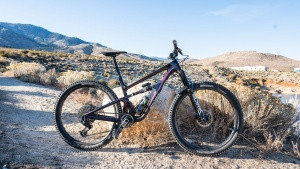 revel rascal xo transmission
revel rascal xo transmission
The Revel Rascal XO Transmission punches well above its weight class, delivering a wildly capable ride that redefines expectations for a mid-travel trail bike. Employing the Canfield Brothers Formula (CBF) suspension and cutting-edge thermoset carbon technology, the Rascal offers a unique and exhilarating trail experience. Its geometry strikes a playful balance, while the 130mm of rear travel allows you to push the limits of what’s typically expected from a bike in this category. The Rascal’s numbers are modern enough to ensure versatility yet retain a lively and agile feel. Revel’s design philosophy for this updated model focused on optimizing the mid-travel trail bike experience, resulting in a 436mm rear center within a 1222mm wheelbase.
Traction is a standout feature of the Rascal, whether clawing up technical climbs or braking through challenging descents. Testers consistently drew comparisons to the Trek Top Fuel 9.8 GX AXS, not due to similar dimensions, but because of the dialed geometry and kinematics that both bikes exhibit. Both the Rascal and Top Fuel offer exceptional ride quality that belies their specifications. Seasoned riders will particularly appreciate the Rascal’s suspension, which effectively isolates rider input, enhancing both pedaling efficiency and small bump sensitivity. The SRAM XO Transmission build, complete with Revel RW30 Carbon wheels and top-of-the-line RockShox suspension, leaves little to be desired in terms of componentry.
While the Rascal lacks frame storage and adjustable geometry, these omissions are easily overlooked given its exceptional performance. Although adjustable geometry can enhance versatility, the Rascal is inherently versatile, excelling on trails that might be considered “too much” for other bikes in its travel category. Conversely, it never feels like overkill on mellower cross-country trails. For performance-oriented riders seeking a no-compromise trail bike, the Rascal is a standout choice, and Revel confidently backs its performance with a guarantee. Among the numerous high-end mountain bikes we test annually, the Rascal is a truly exceptional machine that justifies its premium price tag. We eagerly anticipate a more accessible version of this bike that retains its magic at a lower price point.
Reasons to Buy:
- Exceptional go-anywhere versatility
- Sublime and efficient CBF suspension
- Fantastic Revel RW30 Carbon wheels
Reasons to Avoid:
- High price tag
- Non-adjustable geometry
Overall Score: 88
- Fun Factor: 10.0
- Downhill Performance: 9.0
- Climbing Performance: 8.0
- Ease of Maintenance: 7.0
- Wheel Size: 29-inch
- Rear Travel: 130mm
Read more: Revel Rascal XO Transmission Review
The Revel Rascal XO Transmission is a masterclass in performance and style, offering a playful and capable trail companion.
Best Technical Trail Bike: Yeti SB140 LR T2 TURQ
The Yeti SB140 LR T2 TURQ is a top-tier mid-travel trail bike that delivers a ride characterized by precision and efficiency. This 140mm 29er offers exceptional ride quality and performance that transcends its geometry numbers on paper. Whether you’re tackling steep climbs, flowing trails, high alpine epics, or hitting jump lines, the SB140 is ready for the challenge. Its climbing prowess is remarkable, with excellent traction and a near-ideal riding position. The longer 440mm chainstays keep the rear wheel planted, ensuring traction on technical terrain and challenging ascents.
Pointing the SB140 downhill is equally rewarding. The 65-degree headtube angle inspires confidence, and the suspension maintains excellent small bump sensitivity throughout its travel. While not overly slack, the headtube angle contributes to the bike’s spry and agile feel. The Yeti SB140 strikes a remarkable balance, feeling both composed and playful. It inspires confidence in most terrain, with its speed limit only becoming apparent on the steepest and most extreme trails. While capable of shredding, the SB140 has a refined feel, akin to off-roading in a Range Rover – capable and composed.
If frame storage or adjustable geometry are must-have features, the SB140 might not be the ideal choice. Similarly, more aggressive riders seeking longer, slacker enduro rigs might look elsewhere. However, the Yeti SB140 prioritizes agility and athleticism, relying less on excessive travel and mass. Its exceptional traction allows you to push cornering and braking limits, making it a perfect companion for tackling a vast range of singletrack terrain. Hop on a Yeti SB140 and experience how deftly this bike handles trail duty. For riders seeking a more aggressive option, the Ibis Ripmo V2 XT or Specialized Stumpjumper 15 Comp are excellent alternatives.
Reasons to Buy:
- Phenomenal traction for climbing and descending
- Precise and responsive handling
- Fun and engaging ride on a wide variety of trails
Reasons to Avoid:
- High cost
- Non-adjustable geometry
- No in-frame storage
Overall Score: 86
- Fun Factor: 9.0
- Downhill Performance: 8.0
- Climbing Performance: 9.0
- Ease of Maintenance: 8.0
- Wheel Size: 29-inch
- Rear Travel: 140mm
Read more: Yeti SB140 LR T2 TURQ Review
The Yeti SB140 is characterized by accuracy and adeptness, offering incredible capability in a refined package.
Best Short Travel Trail Bike: Trek Top Fuel 9.8 GX AXS
 trek top fuel 9.8 gx axs
trek top fuel 9.8 gx axs
The latest generation of the Trek Top Fuel 9.8 GX AXS delivers modern geometry and smart updates, redefining the capabilities of a short-travel trail bike. Now categorized as a “down-country” bike, this 120mm OCLV carbon trail bike is surprisingly capable and versatile. It excels on climbs, rivaling modern cross-country bikes with its quick, responsive handling and remarkably supportive pedaling platform. Handling is nimble and quick, with a 76.3-degree seat tube angle that promotes efficient pedaling, even on steep inclines.
Descending prowess is enhanced by Trek’s ABP suspension, which effectively isolates braking forces from the suspension, maintaining composure and control. A 65.9-degree headtube angle strikes a balance, slowing the steering enough for confident descending without compromising its exceptional climbing abilities. The 1227mm wheelbase provides stability and a higher speed limit than one might expect from a short-travel bike. During testing, the Top Fuel consistently exceeded expectations, demonstrating flow, finesse, and true trail pedigree that belies its “short travel” designation.
A clever 4-way Mino-Link allows for geometry and leverage adjustments, and Trek has thoughtfully designed the frame to be compatible with longer shocks and forks, enabling riders to increase travel to 130mm or 140mm. Wheel size options are also versatile: M, ML, L, and XL models come with 29-inch wheels and are mullet (MX) compatible, while the S size features 27.5-inch wheels. Frame storage is integrated with the Bontrager BITS system, keeping essential tools and tubes organized and rattle-free.
The Trek Top Fuel is a well-balanced and highly adjustable trail bike that challenges the notion that trail bikes must have excessive travel. Trek’s confidence in the Top Fuel is underscored by a 30-day Unconditional Guarantee.
Reasons to Buy:
- Mino-Link provides adjustable geometry and suspension leverage
- BITS bag offers convenient downtube storage
- Compatible with 130mm/140mm suspension upgrades
- Mullet (MX) wheel compatibility
Reasons to Avoid:
- Wheels are heavier than ideal
- Short saddle may not suit all riders
Overall Score: 83
- Fun Factor: 8.0
- Downhill Performance: 8.0
- Climbing Performance: 9.0
- Ease of Maintenance: 7.0
- Measured Weight: 29 lbs 9 oz (large)
- Rear Travel: 120mm
Read more: Trek Top Fuel 9.8 GX AXS Review
The Trek Top Fuel proves that short travel doesn’t equate to short fun, offering incredible versatility and an engaging ride.
Best Trail Bike Under $3000: Ibis Ripmo AF NX Eagle
The Ibis Ripmo AF NX Eagle stands out as a formidable trail bike that delivers exceptional performance without breaking the bank. This aluminum-framed version of the acclaimed Ripmo punches well above its price point, offering a combination of brute strength and trail finesse. The 147mm of DW-Link travel and updated suspension kinematics provide a bottomless feel, effectively absorbing bumps and maintaining composure even on aggressive terrain, without sacrificing pedaling efficiency. The Ripmo AF ride is lively, energetic, and playful, encouraging riders to push their limits and tackle bigger features. A 160mm fork and a 64.9-degree headtube angle contribute to its descending prowess, making the Ripmo AF excel when pointed downhill, especially on steeper gradients. Despite its descending focus, the 76-degree seat tube angle and efficient suspension platform make it a surprisingly adept climber, especially considering its weight.
The Ripmo AF feels like a case study in how dialed geometry can elevate rider performance. Ibis has done an excellent job with the component spec, featuring robust suspension, wide rims, capable tires, and a reliable drivetrain. 4-piston brakes and a long dropper post further enhance its capabilities and inspire confidence. The carbon Ripmo, our Editors’ Choice, shares the same platform but with lighter components and a reduced weight.
The primary drawback of the Ripmo AF is its weight. At 34 pounds, it can feel substantial, particularly on climbs. The weight is further emphasized by the suspension, which lacks advanced valving for enhanced pedaling efficiency. It’s also a significant amount of bike, potentially more than some riders need. However, the Ripmo AF is undeniably capable, surprisingly affordable, and incredibly fun.
Reasons to Buy:
- Progressive and aggressive geometry
- Confident and capable descender
- Surprisingly adept climber for its category
Reasons to Avoid:
- Heavy aluminum frame
- Sits at the upper end of the budget price range
Overall Score: 80
- Fun Factor: 8.0
- Downhill Performance: 9.0
- Climbing Performance: 7.0
- Ease of Maintenance: 7.0
- Wheel Size: 29-inch
- Rear Travel: 147mm
Read more: Ibis Ripmo AF NX Eagle Review
The Ibis Ripmo AF is a heavy metal ripper, offering exceptional capability and value for aggressive trail riding on a budget.
Best Full-Suspension Bike Under $2000: Canyon Neuron 5
 mountain bike
mountain bike
The Canyon Neuron 5 is a trail bike that leans into its cross-country roots, offering an exceptional value in the full-suspension category. With 130mm of travel and slightly steeper geometry compared to many trail bikes, the Neuron 5 delivers a snappy and responsive ride quality, making it enjoyable even on less challenging terrain. It resists the trend of overly long and slack geometry, making it ideal for riders who prioritize efficiency and agility over extreme downhill performance. The handling is crisp and responsive, and the Neuron 5 climbs with athleticism, rewarding rider input. Ascending trails and fire roads is a joy on this bike.
However, the Neuron 5’s XC-oriented design reveals its limitations when pushed into rougher, more demanding terrain. The responsive geometry can become overwhelmed at higher speeds in choppy conditions. The 2.4-inch Schwalbe tires, while fast-rolling, lack aggressive knobs and reach their traction limits in loose or technical sections. While capable of handling steep trails, it demands more skill and courage from the rider. The Neuron 5’s weight, while not overly noticeable in general riding, can feel heavy in technical situations.
Reasons to Buy:
- Excellent climber
- Outstanding value for a full-suspension bike
- Geometry provides fun and responsive handling at slower speeds
Reasons to Avoid:
- Optimized for moderate terrain
- Less aggressive tires
- Heavier for its travel category
Overall Score: Not explicitly stated in original text, but implied to be competitive within budget category
- Wheel Size: 29″
- Weight: 33 lbs 10 oz (size large, set up tubeless)
- Rear Travel: 130mm
Read more: Canyon Neuron 5 Review
The Canyon Neuron 5 finds its flow on moderate trails, delivering a fun and engaging ride at an exceptional price point.
Best Budget Mountain Bike: Norco Fluid FS 4
The Norco Fluid FS 4 is our top pick for the best budget mid-travel mountain bike, exceeding expectations and blurring the lines between budget and high-performance. Riding the Fluid FS 4, it’s easy to forget you’re on a “budget bike.” Whether tearing down flow trails or charging through chunky terrain, the Fluid FS 4 is remarkably composed and delivers a genuinely fun riding experience. This impressive on-trail performance is complemented by a stellar build kit, featuring a wide-range cassette and a long-travel dropper post, making it a clear winner for the Best Budget Mountain Bike award.
Our complaints with the Fluid FS 4 are minor. Our extra-large test bike weighed over 36 pounds, which is noticeable in all aspects of its performance. While we typically test large frames, the weight of this extra-large frame is still significant. Climbing performance is adequate, but a climb switch on the rear shock would be beneficial for fire road climbs and smooth doubletrack sections. Budget-conscious shoppers should also consider the Polygon Siskiu T8 as a strong alternative, offering good descending and climbing performance for the price.
Reasons to Buy:
- Very competent on challenging terrain
- Confident at high speeds and on steep trails
- Long-travel dropper post
Reasons to Avoid:
- Heavy overall weight
- No climb switch on the rear shock
Overall Score: 81
- Fun Factor: 8.0
- Downhill Performance: 9.0
- Climbing Performance: 7.0
- Build: 8.0
- Wheels: 29-inch
- Rear Travel: 130mm
Read more: Norco Fluid FS 4 Review
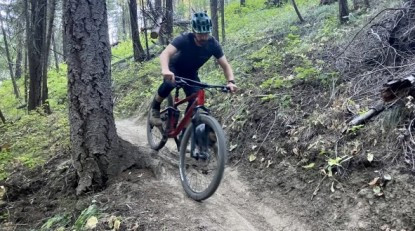 mountain bike – the fluid 4 fs was an incredibly competent descender.
mountain bike – the fluid 4 fs was an incredibly competent descender.
The Norco Fluid FS 4 proves its descending prowess, offering surprising capability for a budget-friendly mountain bike.
Best Electric Mountain Bike: Specialized Turbo Levo Comp Alloy
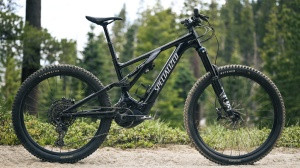 specialized turbo levo comp alloy
specialized turbo levo comp alloy
The Specialized Turbo Levo Comp Alloy remains a dominant force in the electric mountain bike market, even after its last major update in 2022. Like its non-electric counterpart, the Stumpjumper, the Levo features highly adjustable geometry, allowing riders to fine-tune its character to match their riding style, terrain, and preferences. With six distinct geometry settings, the Levo can be configured as a nimble trail bike, an aggressive gravity machine, or anything in between. This unparalleled level of adjustability sets it apart and significantly enhances its versatility. The Levo boasts 150mm of FSR rear wheel travel, a 160mm fork, and mixed wheel sizes (29-inch front, 27.5-inch rear) for a confident front end and playful rear end.
Specialized’s Turbo Full Power 2.2 motor delivers substantial power, with 90Nm of torque and up to 565 peak watts of output, offering three customizable levels of pedal assist. A 700Wh battery integrated into the downtube provides ample range, and the entire system is refined and well-integrated, with balanced weight distribution for a natural ride feel.
The Comp Alloy model is one of the more affordable Turbo Levo builds, offering a functional component package. However, there are a couple of areas for potential improvement. The SRAM Code R brakes are not our preferred choice, and the GRID TRAIL casing tires are not as robust as we’d like for a bike of this weight and capability. While the 700Wh battery offers solid range, with other brands pushing battery capacity, we’d like to see compatibility with a range extender in the future. Despite these minor points, the Turbo Levo remains one of the best and most well-rounded electric mountain bikes available. Its adjustable geometry elevates its versatility to another level. For riders prioritizing maximum range, the Canyon Spectral:ON CF 8 with its 900Wh battery is worth considering.
Reasons to Buy:
- Powerful and refined motor
- Versatile and highly adjustable geometry
- 700Wh battery offers excellent range
Reasons to Avoid:
- No longer leads in battery capacity compared to newer models
- Lower-end models lack a digital display
- Stock tires could benefit from tougher casings
Overall Score: 87
- Downhill Performance: 9.0
- Climbing Performance: 8.0
- Measured Effective Range: 9.0
- Power Output: 9.0
- E-Bike Controls: 7.0
- Wheel Size: MX (29″ front, 27.5″ rear)
- Rear Travel: 150mm
Read more: Specialized Turbo Levo Comp Alloy Review
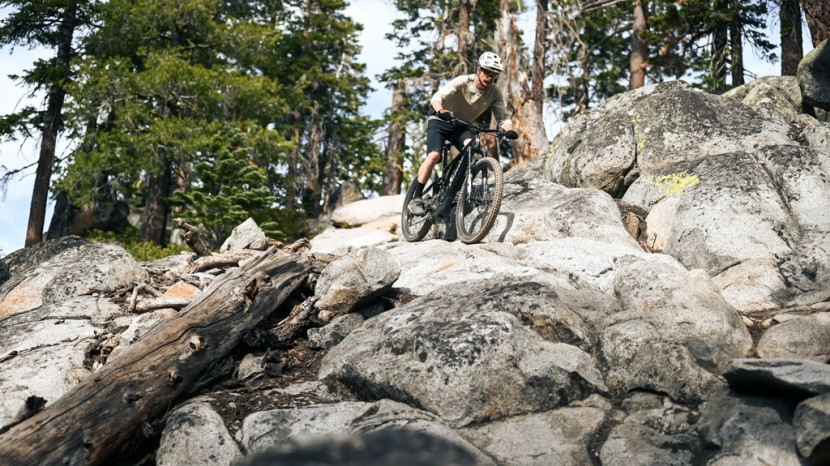 mountain bike – the turbo levo has been refined over the years, and its new…
mountain bike – the turbo levo has been refined over the years, and its new…
The Specialized Turbo Levo boasts years of refinement, with adjustable geometry enhancing its already impressive versatility.
Best Electric Mountain Bike for Range: Canyon Spectral:ON CF 8
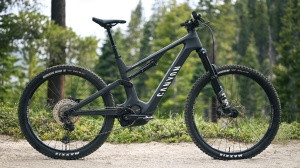 canyon spectral:on cf 8
canyon spectral:on cf 8
Canyon’s updated Spectral:ON models, including the Spectral:ON CF 8, represent a compelling option in the electric mountain bike market, offering versatility and exceptional value. This carbon-framed e-MTB features mixed wheels (29-inch front, 27.5-inch rear), 150/155mm of front/rear travel, and modern trail-oriented geometry. Despite its 50+ pound weight, the Spectral:ON CF 8 handles surprisingly well across varying speeds and terrains, offering a balanced blend of agility, stability, and composure. The popular Shimano EP8 motor provides up to 85Nm of torque with customizable support settings.
The standout feature of the Spectral:ON CF 8 is its massive 900Wh battery, providing the longest range of any electric mountain bike we’ve tested. Canyon’s direct-to-consumer sales model allows for an excellent component build for the price, making it one of the best values in the e-MTB category, although still a significant investment compared to non-electric bikes. While the Spectral:ON CF 8 represents fantastic value, riders considering a high-end e-MTB should also explore the Turbo Levo Comp Alloy, weighing the Levo’s powerful motor and adjustable geometry against the Spectral:ON’s extended range and value proposition.
Reasons to Buy:
- Comparatively reasonable price for its features
- Excellent component build for the price point
- 900 Wh battery provides exceptional range
- Well-rounded trail riding performance
Reasons to Avoid:
- Motor/battery bulge reduces ground clearance
- Non-e-bike specific fork
- Rear tire could be beefier for aggressive riding
Overall Score: 85
- Downhill Performance: 8.0
- Climbing Performance: 8.0
- Measured Effective Range: 10.0
- Power Output: 8.0
- E-Bike Controls: 8.0
- Wheel Size: MX (29″ front, 27.5″ rear)
- Rear Travel: 155mm
Read more: Canyon Spectral:ON CF 8 Review
 mountain bike – the spectral:on cf 8 offers a well-rounded on-trail performance, a…
mountain bike – the spectral:on cf 8 offers a well-rounded on-trail performance, a…
The Canyon Spectral:ON CF 8 delivers well-rounded trail performance, a quality build, and class-leading range thanks to its 900Wh battery, all at a competitive price.
Best Fat Bike: Fezzari Kings Peak Comp
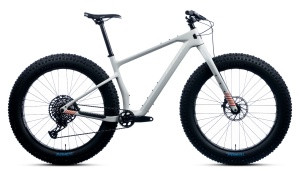 fezzari kings peak comp
fezzari kings peak comp
Fezzari, a direct-to-consumer brand, is making waves in the mountain bike market with quality bikes like the Kings Peak Comp fat bike. With geometry reminiscent of a trail bike, the Kings Peak Comp offers a familiar and comfortable feel on snow and dirt. Fezzari’s 23-point custom setup ensures a tailored fit, and the bike’s angles are well-suited for typical fat bike riding while remaining surprisingly capable outside of normal fat bike terrain. The sleek carbon frame and lightweight build (around 31 pounds) make it pedal efficiently across diverse surfaces. The frame and fork feature numerous mounting points for accessories, ideal for bikepacking and adventure rides. The component spec is functional and reliable, and Fezzari offers more expensive builds and component upgrades.
Aside from minor gripes, the Kings Peak Comp is an excellent fat bike. While we appreciate SRAM Eagle drivetrains, the SX version’s shifter ergonomics are not ideal. The slip-on grips are easily remedied with lock-on replacements. The Clarks M2 brakes offer adequate stopping power for typical fat bike speeds, but long-term durability is uncertain. Overall, the Kings Peak Comp is a top-performing fat bike and receives our recommendation. For conditions not requiring fat tires and prioritizing all-around trail performance, the Ibis Ripmo V2 XT remains an excellent choice.
Reasons to Buy:
- Reasonably priced for a carbon fat bike
- Modern and trail-bike inspired geometry
- Abundant frame and fork mounts for accessories
Reasons to Avoid:
- SRAM SX shifter ergonomics are not ideal
- Slip-on grips are a minor downgrade
Overall Score: 81
- Downhill Performance: 8.0
- Uphill Performance: 8.0
- Versatility: 9.0
- Build: 7.0
- Tire Size: 27.5×4.5-inch
- Fork Travel: N/A (rigid)
Read more: Fezzari Kings Peak Comp Review
 mountain bike – the fezzari kings peak proved to be the best all-around fat bike…
mountain bike – the fezzari kings peak proved to be the best all-around fat bike…
The Fezzari Kings Peak Comp stands out as the best all-around fat bike we’ve tested, blending performance and versatility.
How We Test the Best Mountain Bikes
Our mountain bike testing process is rigorous and hands-on, focused on identifying the top performers on the market. Our experienced team of testers pushes each bike to its limits across a wide variety of terrains, including bike parks, all-day epic rides, long climbs, and demanding descents. We’ve been conducting this comprehensive testing since 2017, evaluating trail bikes, enduro bikes, hardtails, fat bikes, electric mountain bikes, and budget-friendly options. Over the past seven years, we’ve invested over $200,000 in purchasing mountain bikes for review, ensuring objectivity and unbiased assessments. In the rare instances where we utilize media or demo bikes, we insist on paying demo or rental fees to maintain our independence and avoid any potential influence, allowing us to deliver the most unbiased and reliable mountain bike reviews.
Why Trust Us?
Our Senior Mountain Bike Review Editor, Joshua Hutchens, leads our test team. Joshua is a lifelong mountain biker, coach, former racer, guide, and bike shop owner with a refined riding style and extensive experience. Having ridden hundreds of mountain bikes, he possesses a keen ability to discern subtle nuances and performance differences between bikes.
Joshua collaborates with a diverse group of professional bike testers, including former GearLab Mountain Bike Editor and bike shop owner, Pat Donahue. Pat is a talented rider with a preference for steep and technical descents, known for his critical eye and focus on performance-defining characteristics. Kyle Smaine, raised in a mountain biking mecca, is a professional skier and multi-sport athlete with impressive climbing and descending skills, contributing valuable insights to our testing process.
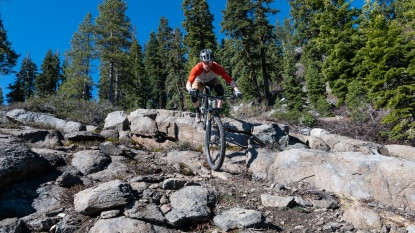 mountain bike – the ripmo v2 is one of our favorite bikes for a reason. there
mountain bike – the ripmo v2 is one of our favorite bikes for a reason. there
The Ibis Ripmo V2 consistently impresses our testers, earning its place as a favorite due to its exceptional all-around performance.
How to Pick the Best Mountain Bike for You: A Buying Guide
Purchasing a mountain bike is a significant investment, and navigating the numerous options can be daunting. Understanding the different types of mountain bikes and key components is crucial to making the right choice. This buying guide will demystify mountain bike jargon and help you narrow down your options based on your riding style and terrain.
Types of Mountain Bikes: Choosing the Right Category
The type of mountain bike you need depends largely on the terrain you plan to ride. Consider your local trails and whether you plan to visit bike parks or trail centers regularly.
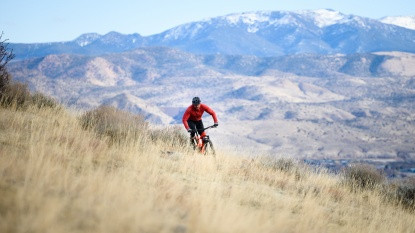 mountain bike – xc bikes are efficient rides for covering long distances and moving…
mountain bike – xc bikes are efficient rides for covering long distances and moving…
Cross-country (XC) bikes are designed for efficiency and speed over long distances and smoother trails.
Cross-Country (XC) Bikes
Cross-country bikes are a specialized category, primarily designed for racing and riders who prioritize weight and efficiency above all else. XC bikes excel on smoother trails but are less versatile on technical or rough terrain. They are typically hardtails (no rear suspension) or feature around 100mm of rear suspension. XC bikes are characterized by steep geometry, low stems, and a firm, unforgiving ride.
XC bikes are suitable for riders who primarily ride smooth trails and prioritize pedaling efficiency and speed. However, for playful riding or trails with roots and rocks, a short-travel trail bike is generally a more enjoyable and capable option, offering similar efficiency with added versatility.
Trail Hardtails
Hardtail mountain bikes offer a simpler, lower-maintenance, and often more affordable entry into mountain biking. They lack rear suspension but feature more aggressive trail bike geometry than XC hardtails, making them efficient pedallers with surprising capability on varied terrain. Hardtails are excellent for developing riding skills, as they require precise line choices and good technique due to their less forgiving nature. While versatile, hardtails can be harsh on descents, and riders frequently tackling steep or rough terrain should consider full-suspension bikes.
Hardtail mountain bikes are a great choice for budget-conscious riders who prioritize riding over tackling extremely technical terrain. They are efficient, fun, and capable of handling a wide range of trails. Explore our selection of hardtail mountain bike reviews for top recommendations.
Short-Travel Trail Bikes
Short-travel trail bikes offer a balance of efficiency and capability, ideal for riders who value variety and efficient climbing without sacrificing full-suspension comfort and confidence. These bikes typically feature 110-130mm of rear-wheel travel, providing a comfortable and capable ride for long days in the saddle and varied terrain. Short-travel trail bikes are well-suited for flatter terrain or mountainous areas where riders don’t prioritize aggressive descending. For a more balanced climbing and descending experience, mid-travel bikes offer even greater versatility.
Short-travel trail bikes are an excellent choice for riders seeking a versatile and efficient full-suspension bike for a wide range of trails. Check out our constantly updated reviews of trail mountain bikes for 110-130mm travel options.
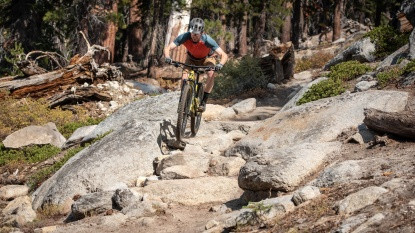 mountain bike – modern short-travel bikes can do it all, only limited by their…
mountain bike – modern short-travel bikes can do it all, only limited by their…
Modern short-travel trail bikes are incredibly versatile, limited only by their modest suspension travel numbers.
Mid-Travel Trail Bikes
Mid-travel trail bikes represent the sweet spot in mountain biking, offering exceptional versatility and strong performance across all areas. These bikes balance climbing efficiency and descending capability beautifully, making them comfortable on the vast majority of trails. Mid-travel bikes are equally at home on occasional bike park trips or 30-mile trail rides. With 130-150mm of suspension travel, they cater to a wide range of riders and terrains. Riders in primarily flat or smooth regions might find mid-travel bikes to be overkill, while those focused on extreme downhill riding may prefer enduro/long-travel bikes.
Mid-travel trail bikes are the most versatile category, ideal for riders who want a bike that can handle everything from daily trail rides to occasional bike park sessions. Explore our trail mountain bike reviews for top picks in the 130-150mm travel range.
Enduro Bikes
Enduro bikes are designed for riders who prioritize descending performance and technical trails, with climbing being a secondary consideration. These long-travel bikes (150-170mm of travel) excel on rough and steep downhills, offering confidence and control when things get challenging. While enduro bikes can pedal uphill, efficiency is not their primary focus, and they are not ideal for long-distance rides or setting climbing records. Enduro bikes are best suited for riders who frequent bike parks, ride aggressive trails, and prioritize downhill performance.
Enduro bikes are for riders who live for the descents and aren’t afraid to carry extra bike uphill to maximize downhill fun.
 mountain bike – enduro bikes are for riders who focus more on the descent than…
mountain bike – enduro bikes are for riders who focus more on the descent than…
Enduro bikes are built for maximum downhill performance, allowing riders to tackle the most technical descents with confidence.
Choosing Bike Components: Fine-Tuning Your Ride
Once you’ve determined the right type of mountain bike, consider these key component decisions to further refine your choice.
Wheel Size: 29-inch vs. 27.5-inch vs. Mixed (Mullet)
Wheel size significantly impacts a mountain bike’s handling and performance. While 26-inch wheels are largely outdated, 27.5-inch and 29-inch wheels are the dominant sizes today, with mixed-wheel setups (mullet) gaining popularity. Larger 29-inch wheels roll over obstacles more easily, maintain momentum better, and offer increased stability at higher speeds. Smaller 27.5-inch wheels are generally more maneuverable and agile, making them potentially more playful in tighter terrain. Mixed-wheel setups combine a 29-inch front wheel for rollover and stability with a 27.5-inch rear wheel for agility and maneuverability. Consider your riding style, terrain, and body size when choosing wheel size. Smaller riders may find 27.5-inch wheels more comfortable, while larger riders may benefit from the rollover capability of 29-inch wheels.
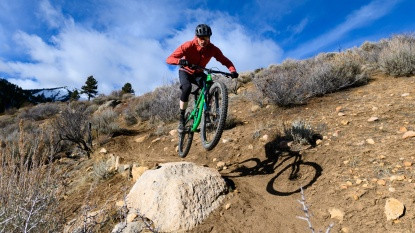 mountain bike – 26-inch wheels are a thing of the past, nearly all bikes have…
mountain bike – 26-inch wheels are a thing of the past, nearly all bikes have…
Mountain bike wheels have evolved, with 27.5-inch and 29-inch sizes dominating the market.
Tire Size and Rim Width: Traction and Rolling Resistance
Tire size and rim width affect traction, rolling resistance, and ride quality. Tire widths have generally increased over time, with 2.4-2.5-inch tires becoming common on trail bikes, and even wider 2.6-inch options gaining popularity. Wider tires offer increased air volume and a larger contact patch, enhancing traction and providing a slightly softer ride, but may increase rolling resistance on climbs. Plus-size tires (2.8-3.0 inches) offer even more traction but can feel vague in corners. Rim width should be matched to tire size, with wider rims supporting wider tires for optimal performance. For aggressive trail and enduro riding, rims in the 28-35mm range are recommended, while less aggressive bikes can use narrower rims. Consult manufacturers or dealers for recommended tire and rim width compatibility. Upgrading tires is a cost-effective way to improve bike performance. Explore our mountain bike tire reviews for top recommendations.
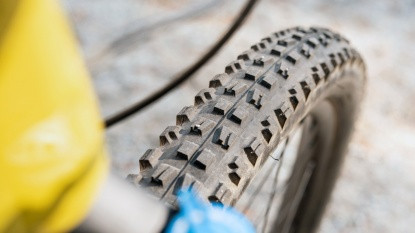 mountain bike – the right tires can make a huge difference in the performance of…
mountain bike – the right tires can make a huge difference in the performance of…
Choosing the right mountain bike tires, like the popular Maxxis Minion DHF, can significantly impact your bike’s performance.
Complete Bike Build: Frame, Suspension, Drivetrain, and Wheelset
When choosing a complete mountain bike, consider the frame material, suspension components, drivetrain, and wheelset.
-
Frame Material (Aluminum vs. Carbon): Aluminum frames are more affordable but generally heavier and less stiff than carbon frames. Carbon frames offer weight savings, increased stiffness, and improved vibration damping, but come at a higher price. Carbon fiber frames also tend to age better than aluminum.
-
Fork and Rear Shock: Higher-end suspension components offer greater adjustability, improved performance, and increased durability. Heavier riders may benefit from coil-sprung suspension, while lighter riders may find air suspension sufficient.
-
Drivetrain (1x vs. 2x): Modern mountain bikes predominantly use 1x drivetrains (single front chainring) for simplicity, ease of shifting, and dropper post compatibility. 1x drivetrains typically offer 11 or 12 gears.
-
Wheelset: Higher-quality wheelsets improve ride quality, durability, and often reduce weight. Rim width is a crucial factor to consider, ensuring compatibility with your preferred tire size. Carbon fiber rims are lighter and stiffer than aluminum rims but are significantly more expensive.
 mountain bike – most bikes are offered in a range of build kits and prices.
mountain bike – most bikes are offered in a range of build kits and prices.
Mountain bikes are typically offered in various build kits and price points, allowing you to choose components that match your budget and riding needs.
 mountain bike – most bikes come with 1x drivetrains that have a huge gear range.
mountain bike – most bikes come with 1x drivetrains that have a huge gear range.
Most modern mountain bikes are equipped with 1x drivetrains, offering a wide gear range and simplified shifting.
Women’s Mountain Bikes: Fit and Tune
Most mountain bikes are marketed as unisex models. However, some manufacturers offer women-specific models that address the fit and suspension needs of female riders. Women-specific bikes often feature lighter shock tunes, women’s saddles, smaller grips, and sometimes narrower handlebars and shorter cranks. Frame geometry may also be adjusted in some cases. The most critical aspects of women’s mountain bikes are proper sizing and appropriate suspension tuning for lighter riders. Many manufacturers now use lighter shock tunes on smaller frame sizes to better accommodate smaller and lighter riders, regardless of gender. Ensure the bike fits properly and the suspension is tuned to your weight and riding style.
Women’s specific mountain bikes often feature components like women’s saddles, narrower handlebars, and lighter shock tunes.
 mountain bike – making bikes smaller with lighter shock tunes for smaller riders…
mountain bike – making bikes smaller with lighter shock tunes for smaller riders…
Proper sizing and lighter shock tunes are key considerations for smaller riders, whether on unisex or women-specific mountain bikes.
Consumer Direct vs. Local Bike Shop: Purchase Options
Mountain bikes can be purchased through consumer-direct brands or local bike shops. Consumer-direct brands like YT, Commencal, and Canyon offer competitive prices by selling directly to consumers, cutting out the bike shop middleman. Purchasing from a local bike shop often provides valuable services, including bike assembly, maintenance, warranty support, and expert advice. Consider your mechanical skills, desire for local support, and budget when choosing between consumer-direct and local bike shop purchases.
 mountain bike – minimal assembly required. slap on the wheels and the handlebars…
mountain bike – minimal assembly required. slap on the wheels and the handlebars…
Consumer-direct mountain bikes often require minimal assembly, but consider your comfort level with bike mechanics.
Multiple Bikes: Building a Quiver
For dedicated mountain bikers, owning multiple bikes, or a “quiver,” can optimize performance for different riding styles and terrains. A short-travel trail bike and an enduro bike can cover a wide range of riding needs. However, for most riders, a versatile mid-travel trail bike is the best all-around option, capable of handling diverse trails and occasional bike park visits. Renting a longer-travel bike for specific bike park trips can be a cost-effective alternative to owning multiple bikes.
 mountain bike – more bikes mean more specific talents and more to maintain.
mountain bike – more bikes mean more specific talents and more to maintain.
Owning multiple mountain bikes allows you to optimize performance for different riding disciplines, but requires more maintenance and investment.
Trainers, Exercise Bikes, and the Off-Season: Staying Fit Indoors
For riders facing off-seasons or time constraints, indoor training options like exercise bikes and bike trainers offer effective ways to maintain fitness. Interactive exercise bikes and bike trainers provide engaging and motivating indoor riding experiences, allowing you to train on your own bike or participate in virtual group rides. Treadmills also offer an alternative off-season fitness option for those seeking a break from cycling.
Conclusion: Get Out and Ride
Choosing the best mountain bike involves careful consideration of your riding style, terrain, budget, and component preferences. This guide provides a comprehensive overview of the top mountain bikes and key buying factors to help you make an informed decision. The most important step is to get out and ride! Explore the trails, test ride different bikes, and discover the joy of mountain biking. OutdoorGearLab will continue to test and review the top mountain bikes to keep this guide current and help you find your perfect ride.
 mountain bike – there are loads of great mountain bikes to choose from. get a bike…
mountain bike – there are loads of great mountain bikes to choose from. get a bike…
With a wide range of excellent mountain bikes available, the best thing to do is choose a bike and start exploring the trails!

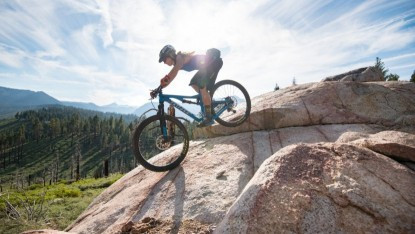 mountain bike – women
mountain bike – women